The Influence Professional software has the ability to provide methods of searching all the CVs and candidate records stored within the database to allow users to extract a well-suited shortlist with the required skills to fulfil any vacancies which may exist on the database. The 2 Influence searching mechanisms are described below.
|
Note: Much of the searching can now be done from the [Candidates] workbench so there is little need to go to the older [Searching] system. From the workbench you can directly search for CV Text, Attributes (Skills) as well as Roles and 'enhanced' fields such as Date of Birth or Nationality. Click here for more Info |
Contents (Click an Item to Jump to that section)
2. Adding Grid Selection/Layouts
Searching From Candidate Workbench
After release 1.00.18.116 a new feature has been added to the [Candidates] workbench.
It will allow users to search for candidates based upon Journals they have received.
To start a new (ad hoc) search
Select the Candidates Workbench
The workbench has several filters which can be used to search and some of these are described below:
Status
Typically user will look at LIVE candidates (this typically shows anyone with a status of LIVE or RAW, depending on your system configuration). You can also search by filtering by Status Change date, which is described below.
Consultants
Search by the user that owns the record
Attributes
The Attributes within the system, and will display a selection window from where the user can specify the elements of their query.
Postcode
User can enter information into the postcode field to identify candidate with that postcode. If the Radius Search module has been purchased then it is also possible to search for people within a radius of the centre of the postcode, e.g. RH1 [10] would find candidates within 10 miles of RH1.
Compliance Filter
This filter works similarly to the 'filter' shown above. Users can construct complex queries to identify candidate records based upon their compliance items.
An example is shown below
This will search for any candidate whose Fire Safety Training expires within 30-days *if* they have Fire Safety Training 'ticked'. (i.e. Criteria 1 and 2 are applied)
Filter Criteria
The Filter criteria at the top of the workbench allows users to specify more complex logic using almost any field from the candidate record.
There are 10 lines of criteria which can be specified. The system decides which of those lines are in use by looking at the Logic Line below the criteria grid.
It is probably best illustrated by an example;
Line What Description Rel Logic Value1 Value2 Value3
1 CRDT Creation Date GE AND 01/11/09
2 PERM Requires Perm Work EQ AND N
3 CNTY County EQ OR ESSEX SURREY
Logic Line [1&2&3 ] < this indicates that the system should use lines 1&2&3 (OR’s can be indicated with / e.g. 1/2/3 )
The example above will select candidates created on or after 1st Nov 09, who do NOT have the ‘Perm’ work box ticked, and who have the County field of their address set to Essex or Surrey.
| Note: Any criteria within the Enhanced Filter will get used in addition to anything specified on any of the other filters on the workbench. |
Status Change Date Filter
(Available from version 1.00.15.321)
It is possible to filter the [Candidates] workbench by Status Change date.
This allows you to find out information such as all candidates which were set to "LIVE" during a given period, or any candidate whose status became "Found Own Job" in October.
How it works
There are some new filters at the top of the [Candidates] workbench for Date Type and Select Range. (also Date) These can be used to filter the list of candidates.
Example:
If you set the workbench to filter using Date Type = Status Change, Select Range = Last Month and Status = Placed
The system will return a list of candidates whose STATUS has changed to "Placed" during last month. (Although their status may not currently be placed.)
As long as they were changed to placed during "Last Month" they will be reported regardless of their current status.
| Notes/Considerations When using the Date Type of "Status Change" it is also possible to combine this with the [Status] multi-selector at the left hand side, in the Favourites bar. For example you may wish to produce a list of any consultants where their STATUS has gone-through "Found Own Job" or "No Further Action" during the last week. |
Compliance Filter
This allows users to search for candidates based upon their Compliance items.
The filter opens a second window and allows users to specify up to 20 criteria which can then be combined using logic to test if the candidate should be returned or not.
How it works
To use the compliance filter simply click into the box and click the [...] button.
The system will open a 'Logic' screen. Users can compose up to 20 questions based upon any of the defined compliance items within their system, and then combine these questions using the Login Line below
e.g. To check for people who have a passport and also have a driving licence, which is due to expire before 31st July, you could setup a query as detailed below
| Compliance |
Field |
Comparison |
Value |
| Passport |
Checked |
Equals |
Yes |
| Driving Licence |
Expiry Date |
Is less than |
31/07/2016 |
| Driving Licence |
Checked |
Equals |
Yes |
Logic Line [ 1 & 2 & 3 ]
An example of the Logic screen is show below.
Once you click [OK] the criteria which have been specified will be saved back, and you will be returned to the [Candidates] workbench.
Pressing [Go] or [Refresh] on the main workbench will run the query (along with any other criteria which may have been specified on the workbench) and will return a list of matching candidates.
| Note: When using the filter to look at compliance items with an expiry date, a new field has been added to the selections called "Days to Expiry". This allows users to setup a query/Favourite which will consistently look for things which expire within a fixed time frame |
| Note: If you have a 'Favourite' view saved on the candidate workbench that uses this compliance criteria it should be noted that Coming into this 'advanced' screen and amending the criteria will save the changes back into the Favourite when you press [OK] i.e. If you had a favourite saved with these criteria set one way, coming oin and amending them will immediately update the favourite view to the amended criteria as soon as you exit this screen. |
CV Text Search filter
This filter allows users to perform a Boolean text search on the text of the candidates’ CVs.
This particular search relies upon an indexing service which is running on the server, and pre-indexes all CV documents which exist on the server. As such is very fast. It is best illustrated by an example.
“ORDER MANAGEMENT” AND (EDI OR “WEB PURCHASING”)
Searching for the string above will return a list of candidates containing the phrase Order Management on their CV and one of either EDI or “Web Purchasing” in addition to the Order Management phrase.
| Note: Any CV text searching is performed in addition to criteria specified on any other filters above the workbench. |
Search by Journals
(Available from Version 1.00.18.116)
How it Works
Select the [Candidates] workbench. click the Journals filter at the top of the workbench to open the Journals Enhanced Search box.
Within the search box you can enter up to 10 criteria which will be applied. Each criteria can apply some logic such as EQ (equal), GT (Greater than), GE (Greater than or Equal), LT (Less Than), LE (Less than or Equal to), etc, etc.
The Logic Line below these criteria will tell the system how to combine these using & (AND) and / (OR). For example (1&2)/3 would apply criteria 1 AND 2, OR 3.
The following items are available to search;
| Body |
Will search in the body text of the Journal. |
| Date |
Will search using the date of the Journal. |
| Dir |
Direction. Looks at the Direction of the Journal (Usually In/Out) |
| Meth |
Method, such as E (email), P (Phone), S (SMS), etc. |
| Ref |
Search the contents of the Reference field displayed on the Journal Entry page. |
| Res |
Search on the Result recorded on the Journal Entry page. |
| Subj |
Search the Subject of the Journal for particular text. |
| Type |
Search based upon the Call Type of the Journal. |
| User |
Search for the USER_ID of the person who recorded/stored the Journal in the database. |
Examples:
Some example searches are shown below to help users to understand the sort of searches which are possible with this feature.
Example 1:
This search will find anyone who has had a Journal on or after 01/05/2018 logged by the user GO or ADM.
Example 2:
This looks for people who have had any Journal between 1st Jan 2018 - 31st March 2018 <OR> If they have EVER had a journal of the Call Type COM (Complaint)
Example 3:
This looks for people with a Journal which has direction set to I (inward), Method P (phone), E (email) or S (SMS) on or after 01/01/2017.
Availability Date Search
January 2017 has brought several enhancements to the Influence professional database.
One such enhancement is an improved availability date search directly from the candidate workbench.
Using the "Date Type" drop-down you can select the new Start and End date type.
You can then enter a date into the date range below, and the system will find any candidate who has the "available From" date set prior to this date. In combination with the Contract=Y filter this allows you to easily home-in on contractors who will become available on or before a specified date.
By using Groups and Select you can then easily choose some of these candidates and Match them to a LIVE vacancy.
Searching System (Older)
Most searches can be done from the [Candidate] workbench - See above - But if you need to use the older [Searching] system this can be done in the following way.
Select the Searching area of the workbench at the bottom left. Choose the [candidates] button and then click on the NEW icon to initiate a new search.
(It is possible to open previous searches by selecting any of the historic magnifying glass icons, such as “last week”, “last month”, etc.)
Once the search screen opens, give the search a name, and then click [Apply]. The system will then allow users to click the [Criteria] button and choose the Key Codes/Attributes that they wish to search for.
The criteria selection screen (shown below) allows users to choose the Key Codes/Attributes that they wish to search for. It is possible to search the skills matrix by setting the show drop-down to All, and then entering details of a criteria into the filter field at the bottom left of the screen.
In order to add a Key Code/Attribute to the Query, just click on the attribute itself in the attribute tree (e.g. DB2, MySQL or ORACLE) and it will be added to the Query on the right of the screen. Key Codes/Attributeswhich have been selected will be indicated by a small grey bar to the left of the Key Code/Attribute itself in the attribute tree.
It is possible to determine the LOGIC for the query by choosing the ‘AND/OR’ column in the query grid. Brackets can be added to the query logic by clicking the relevant columns of the Query logic grid. (In the example above, there are brackets before Oracle and after MySQL)
The screenshot above shows that the Key Codes/Attributes for Db2, My SQL and Oracle have been selected from the Attribute tree. They have then been combined together as
(Oracle OR MySQL) and DB2
i.e. The system will search for candidates who must have the DB2 attribute, plus one of either Oracle or MySQL.
You can Test the search logic by clicking the [Test] button at the bottom of the screen.
When happy with the search logic you have created, simply click [OK] to return to the search screen.
The LOGIC you have created will be shown in the criteria area (highlighted in yellow). Click the [Search] button at the bottom left of the screen to actually run the search.
Once a list of candidates has been returned you can MARK the candidates by clicking the Tick All button (or Cross All)
Clicking [OK] will save the search and then exit from the results page.
Adding Grid Selections/Layouts added to older [Searching] screens
After version 1.00.22.065 these older [Searching] screens in Influence now allow users to create their own 'Results' Grid which can be applied to any search results.
Horizontal/Vertical lines can be applied by clicking the 'Grid' icon (each click cycles through Horizontal/Vertical/Both/None)
Grid Layouts can be Applied by clicking the 'Grid Layout' icon and choosing a layout.
It is possible to design New Layouts for the Search results by clicking the small Plus (+) at the top left of the Format selection window.
Search Tips:
|
Keywords:Run, Candidates, Search, Test
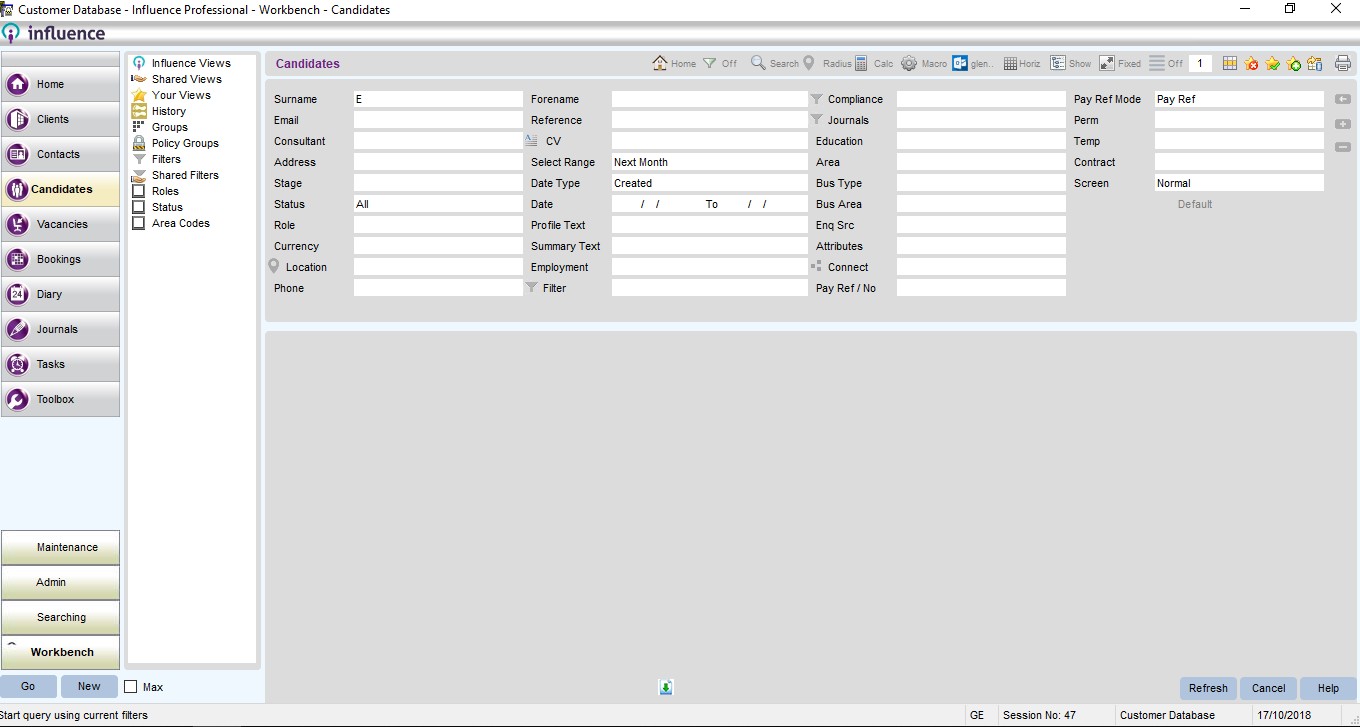
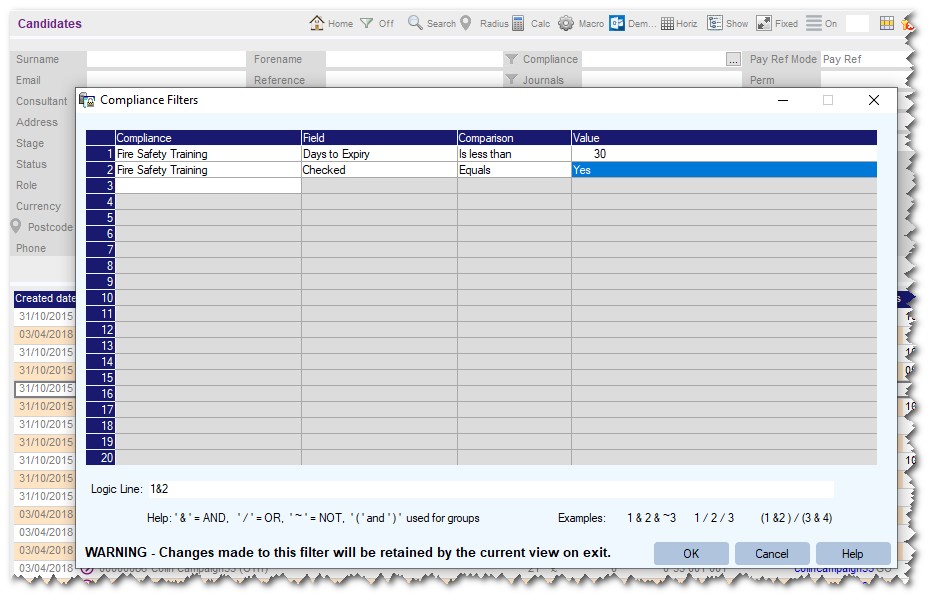
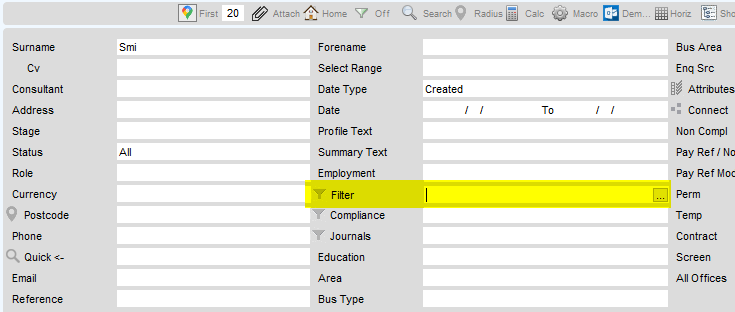
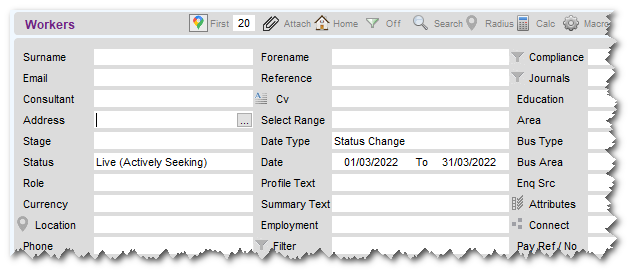
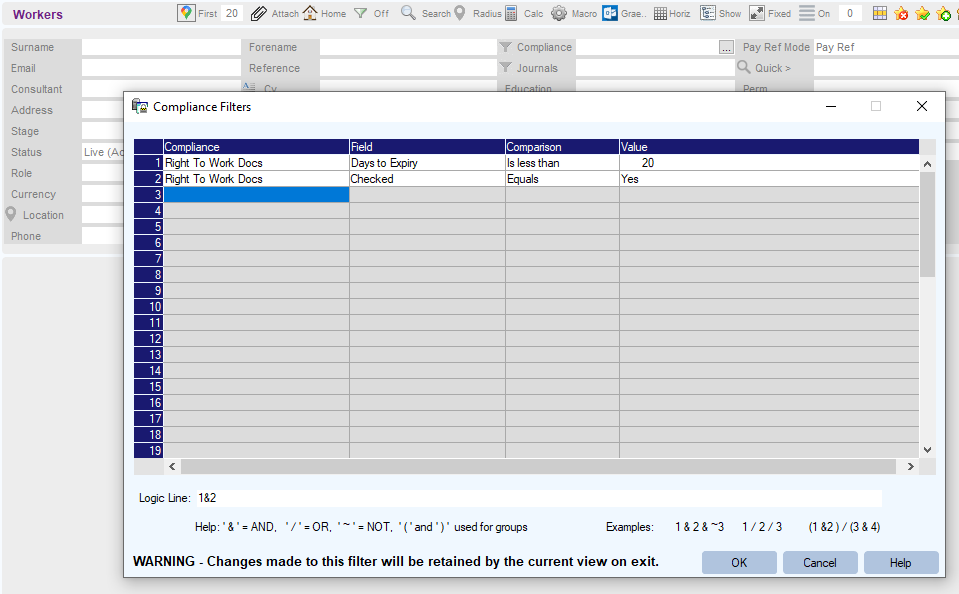
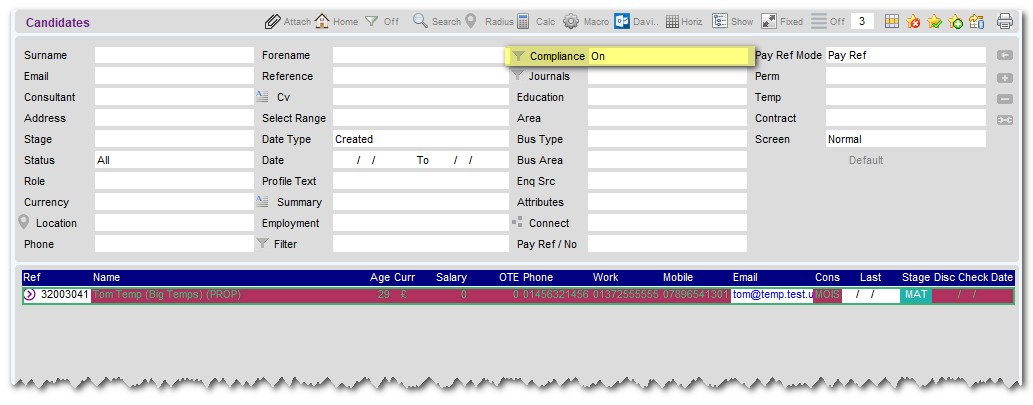
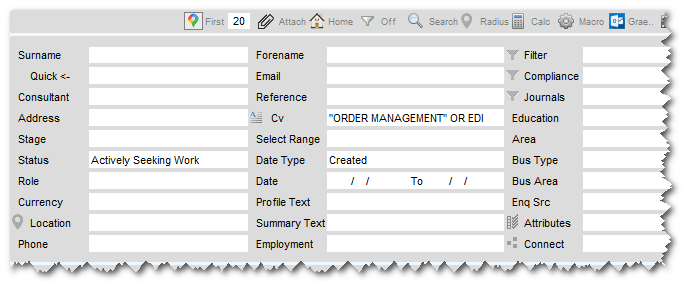
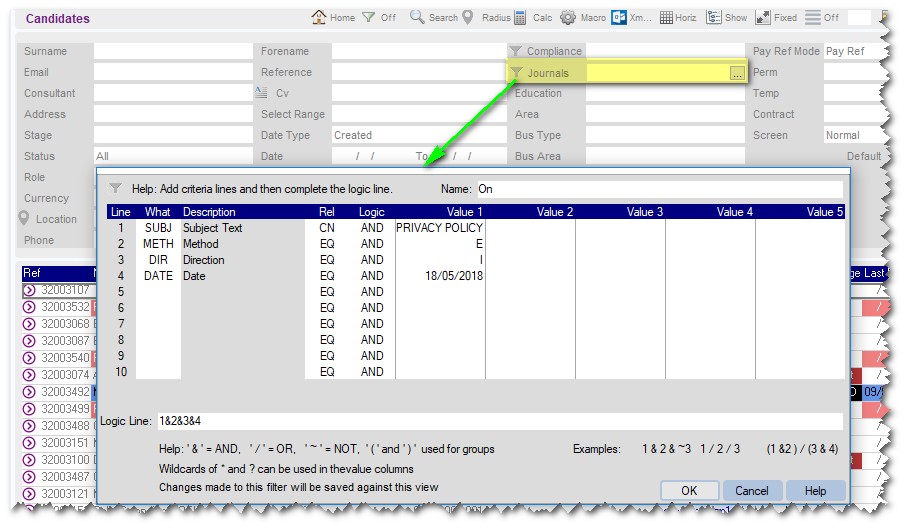
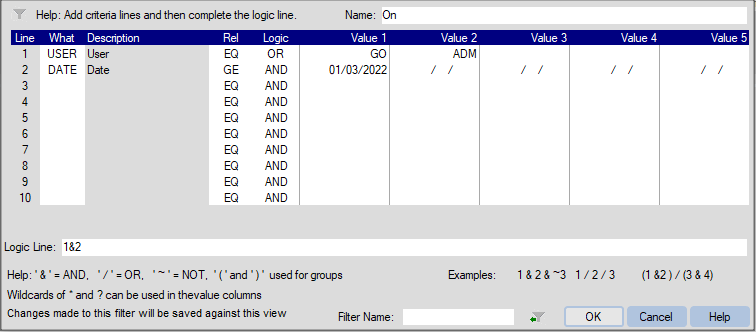
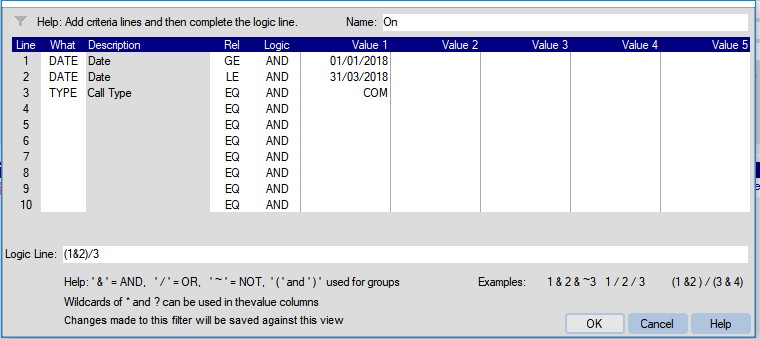



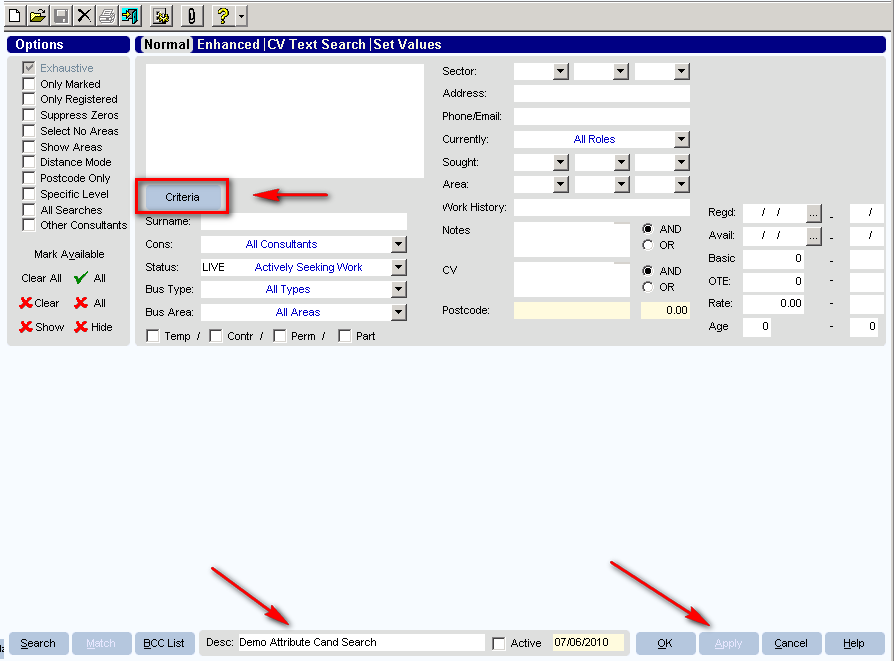
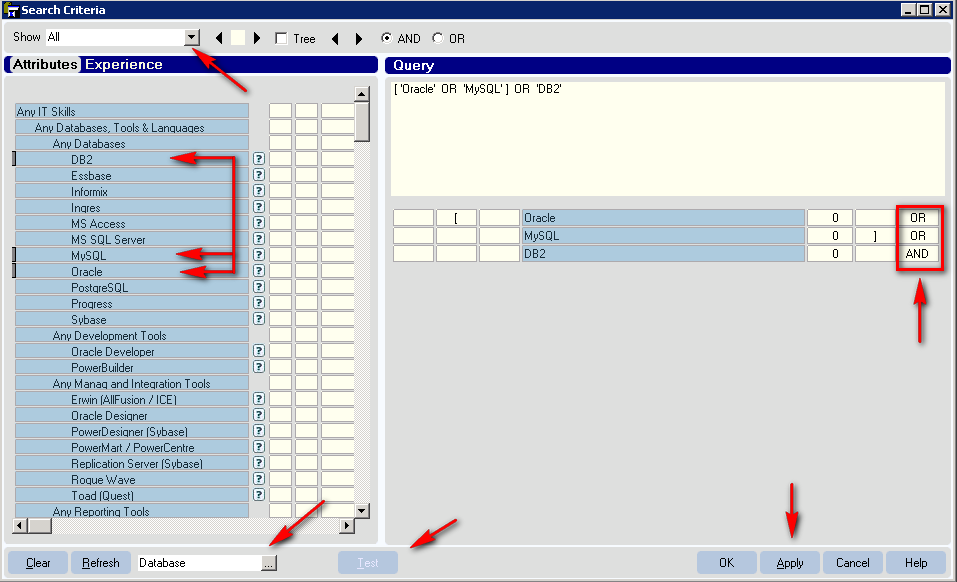
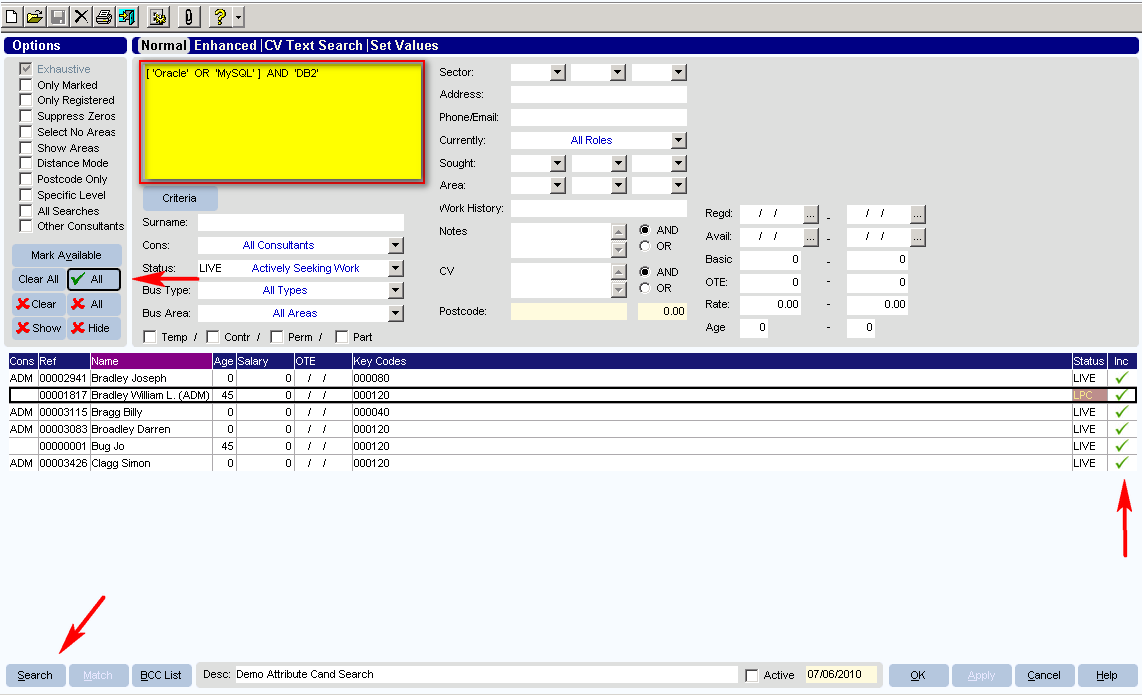




Martin Parkinson
Comments